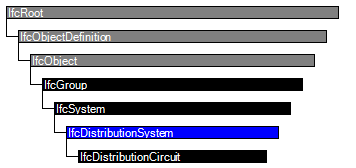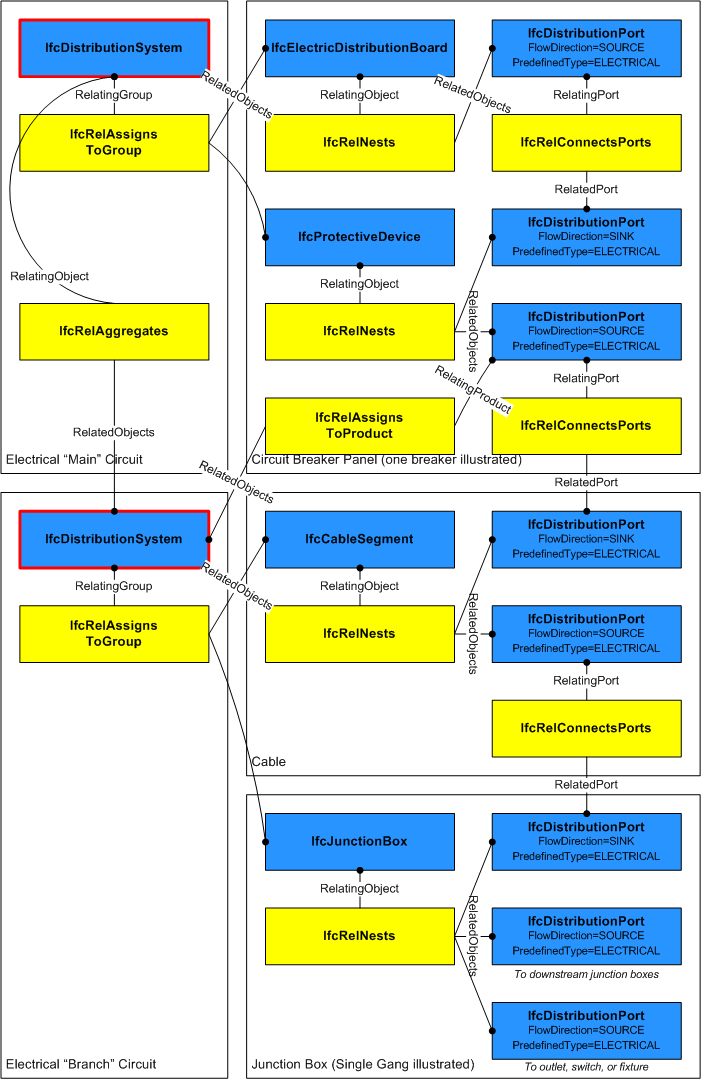Natural language names
 | haustechnische Anlage |
 | Distribution System |
 | Système de distribution |
 | haustechnische Anlage |
 | Distribution System |
 | Système de distribution |
| Item | SPF | XML | Change | Description | IFC2x3 to IFC4 |
|---|---|---|---|---|
| IfcDistributionSystem | ADDED |
A distribution system is a network designed to receive, store, maintain, distribute, or control the flow of a distribution media. A common example is a heating hot water system that consists of a pump, a tank, and an interconnected piping system for distributing hot water to terminals.
The group IfcDistributionSystem defines the occurrence of a specialized system for use within the context of building services.
Important functionalities for the description of a distribution system are derived from existing IFC entities:
HISTORY New entity in IFC4.
IFC4 CHANGE For electrical power systems, IfcElectricalCircuit has been used for low-voltage (12-1000 V) power circuits and has been replaced by IfcDistributionCircuit in IFC4; IfcDistributionSystem with PredefinedType 'ELECTRICAL' should be used for overall power systems, and IfcDistributionCircuit with PredefinedType 'ELECTRICAL' should be used for each switched circuit.
| # | Attribute | Type | Cardinality | Description | C |
|---|---|---|---|---|---|
| 6 | LongName | IfcLabel | [0:1] |
Long name for a distribution system, used for informal purposes. It should be used, if available, in conjunction with the inherited Name attribute.
NOTE In many scenarios the Name attribute refers to the short name or number of a distribution system or branch circuit, and the LongName refers to a descriptive name. | X |
| 7 | PredefinedType | IfcDistributionSystemEnum | [0:1] | Predefined types of distribution systems. | X |

| # | Attribute | Type | Cardinality | Description | C |
|---|---|---|---|---|---|
| IfcRoot | |||||
| 1 | GlobalId | IfcGloballyUniqueId | [1:1] | Assignment of a globally unique identifier within the entire software world. | X |
| 2 | OwnerHistory | IfcOwnerHistory | [0:1] |
Assignment of the information about the current ownership of that object, including owning actor, application, local identification and information captured about the recent changes of the object,
NOTE only the last modification in stored - either as addition, deletion or modification. | X |
| 3 | Name | IfcLabel | [0:1] | Optional name for use by the participating software systems or users. For some subtypes of IfcRoot the insertion of the Name attribute may be required. This would be enforced by a where rule. | X |
| 4 | Description | IfcText | [0:1] | Optional description, provided for exchanging informative comments. | X |
| IfcObjectDefinition | |||||
| HasAssignments | IfcRelAssigns @RelatedObjects | S[0:?] | Reference to the relationship objects, that assign (by an association relationship) other subtypes of IfcObject to this object instance. Examples are the association to products, processes, controls, resources or groups. | X | |
| Nests | IfcRelNests @RelatedObjects | S[0:1] | References to the decomposition relationship being a nesting. It determines that this object definition is a part within an ordered whole/part decomposition relationship. An object occurrence or type can only be part of a single decomposition (to allow hierarchical strutures only). | X | |
| IsNestedBy | IfcRelNests @RelatingObject | S[0:?] | References to the decomposition relationship being a nesting. It determines that this object definition is the whole within an ordered whole/part decomposition relationship. An object or object type can be nested by several other objects (occurrences or types). | X | |
| HasContext | IfcRelDeclares @RelatedDefinitions | S[0:1] | References to the context providing context information such as project unit or representation context. It should only be asserted for the uppermost non-spatial object. | X | |
| IsDecomposedBy | IfcRelAggregates @RelatingObject | S[0:?] | References to the decomposition relationship being an aggregation. It determines that this object definition is whole within an unordered whole/part decomposition relationship. An object definitions can be aggregated by several other objects (occurrences or parts). | X | |
| Decomposes | IfcRelAggregates @RelatedObjects | S[0:1] | References to the decomposition relationship being an aggregation. It determines that this object definition is a part within an unordered whole/part decomposition relationship. An object definitions can only be part of a single decomposition (to allow hierarchical strutures only). | X | |
| HasAssociations | IfcRelAssociates @RelatedObjects | S[0:?] | Reference to the relationship objects, that associates external references or other resource definitions to the object.. Examples are the association to library, documentation or classification. | X | |
| IfcObject | |||||
| 5 | ObjectType | IfcLabel | [0:1] |
The type denotes a particular type that indicates the object further. The use has to be established at the level of instantiable subtypes. In particular it holds the user defined type, if the enumeration of the attribute PredefinedType is set to USERDEFINED.
| X |
| IsDeclaredBy | IfcRelDefinesByObject @RelatedObjects | S[0:1] | Link to the relationship object pointing to the declaring object that provides the object definitions for this object occurrence. The declaring object has to be part of an object type decomposition. The associated IfcObject, or its subtypes, contains the specific information (as part of a type, or style, definition), that is common to all reflected instances of the declaring IfcObject, or its subtypes. | X | |
| Declares | IfcRelDefinesByObject @RelatingObject | S[0:?] | Link to the relationship object pointing to the reflected object(s) that receives the object definitions. The reflected object has to be part of an object occurrence decomposition. The associated IfcObject, or its subtypes, provides the specific information (as part of a type, or style, definition), that is common to all reflected instances of the declaring IfcObject, or its subtypes. | X | |
| IsTypedBy | IfcRelDefinesByType @RelatedObjects | S[0:1] | Set of relationships to the object type that provides the type definitions for this object occurrence. The then associated IfcTypeObject, or its subtypes, contains the specific information (or type, or style), that is common to all instances of IfcObject, or its subtypes, referring to the same type. | X | |
| IsDefinedBy | IfcRelDefinesByProperties @RelatedObjects | S[0:?] | Set of relationships to property set definitions attached to this object. Those statically or dynamically defined properties contain alphanumeric information content that further defines the object. | X | |
| IfcGroup | |||||
| IsGroupedBy | IfcRelAssignsToGroup @RelatingGroup | S[0:?] | Reference to the relationship IfcRelAssignsToGroup that assigns the one to many group members to the IfcGroup object. | X | |
| IfcSystem | |||||
| ServicesBuildings | IfcRelServicesBuildings @RelatingSystem | S[0:1] | Reference to the | X | |
| IfcDistributionSystem | |||||
| 6 | LongName | IfcLabel | [0:1] |
Long name for a distribution system, used for informal purposes. It should be used, if available, in conjunction with the inherited Name attribute.
NOTE In many scenarios the Name attribute refers to the short name or number of a distribution system or branch circuit, and the LongName refers to a descriptive name. | X |
| 7 | PredefinedType | IfcDistributionSystemEnum | [0:1] | Predefined types of distribution systems. | X |
Property Sets for Objects
The Property Sets for Objects concept applies to this entity as shown in Table 219.
| |||||||||||||||||||||||||||||||||||||
Table 219 — IfcDistributionSystem Property Sets for Objects |
Aggregation
The Aggregation concept applies to this entity as shown in Table 220.
| |||||||||
Table 220 — IfcDistributionSystem Aggregation |
Group Assignment
The Group Assignment concept applies to this entity as shown in Table 221.
| ||||
Table 221 — IfcDistributionSystem Group Assignment |
For the most common case of an IfcDistributionElement subtype containing ports of a particular PredefinedType that all belong to the same distribution system, the IfcDistributionElement is assigned to the IfcDistributionSystem via the IfcRelAssignsToGroup relationship, where IfcDistributionPort's are implied as part of the corresponding system based on their PredefinedType. An IfcDistributionElement may belong to multiple systems, however only one IfcDistributionSystem of a particular PredefinedType.
For rare cases where an IfcDistributionElement subtype contains ports of the same PredefinedType yet different ports belong to different systems, alternatively each IfcDistributionPort may be directly assigned to a single IfcDistributionSystem via the IfcRelAssignsToGroup relationship, where the PredefinedType must match. Such assignment indicates that the IfcDistributionSystem assigned from the IfcDistributionPort overrides any such system of the same PredefinedType assigned from the containing IfcDistributionElement, if any.
Additionally, an IfcDistributionSystem may in turn be assigned to an IfcDistributionPort indicating the host or origination of the system using IfcRelAssignsToProduct.
EXAMPLE A gas-powered hot water heater may have three ports: GAS, DOMESTICCOLDWATER, and DOMESTICHOTWATER. The heater is a member of two systems (GAS and DOMESTICCOLDWATER), and hosts one system (DOMESTICHOTWATER) at the corresponding port.
Figure 262 illustrates a distribution system for an electrical circuit.
 |
Figure 262 — Distribution system assignment |
| # | Concept | Model View |
|---|---|---|
| IfcRoot | ||
| Software Identity | Common Use Definitions | |
| Revision Control | Common Use Definitions | |
| IfcObject | ||
| Object Occurrence Predefined Type | Common Use Definitions | |
| IfcGroup | ||
| IfcSystem | ||
| IfcDistributionSystem | ||
| Property Sets for Objects | Common Use Definitions | |
| Aggregation | Common Use Definitions | |
| Group Assignment | Common Use Definitions | |
<xs:element name="IfcDistributionSystem" type="ifc:IfcDistributionSystem" substitutionGroup="ifc:IfcSystem" nillable="true"/>
<xs:complexType name="IfcDistributionSystem">
<xs:complexContent>
<xs:extension base="ifc:IfcSystem">
<xs:attribute name="LongName" type="ifc:IfcLabel" use="optional"/>
<xs:attribute name="PredefinedType" type="ifc:IfcDistributionSystemEnum" use="optional"/>
</xs:extension>
</xs:complexContent>
</xs:complexType>
ENTITY IfcDistributionSystem
SUPERTYPE OF(IfcDistributionCircuit)
SUBTYPE OF (IfcSystem);
LongName : OPTIONAL IfcLabel;
PredefinedType : OPTIONAL IfcDistributionSystemEnum;
END_ENTITY;